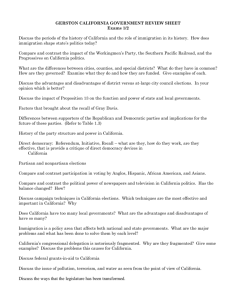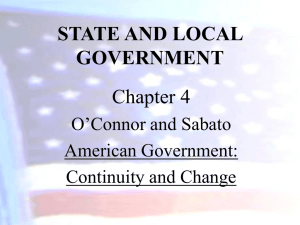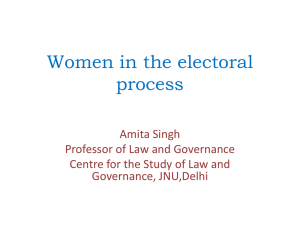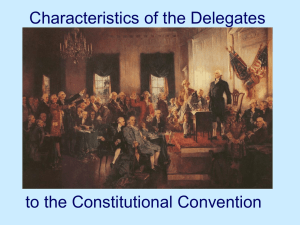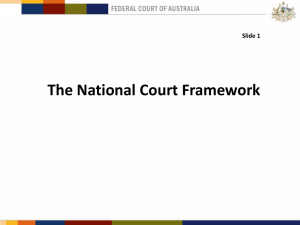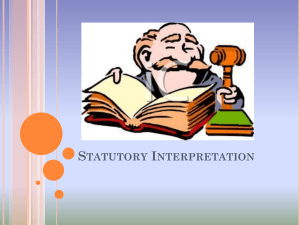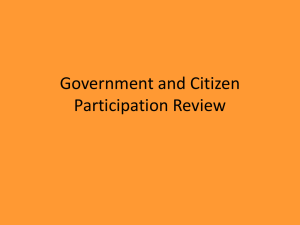Chapter 4: State and Local Government
advertisement
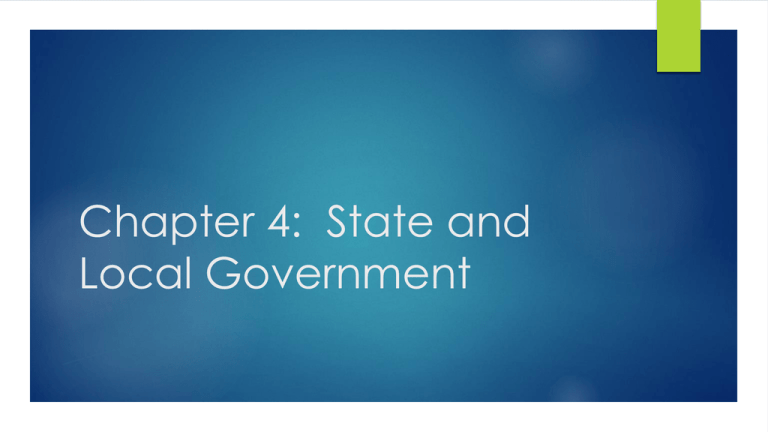
Chapter 4: State and Local Government The United STATES The State was the original unit of government (Articles of Confederation). State governments used to create/give power to the Federal government. (Confederation) State governments still create all local governments School Boards Cities Counties Townships Local governments still derive power from citizens, but citizens create local government by petitioning the state government. Cooperative Federalism Growth of full-time, professional state and local governments. No guarantees that urban populations would be well represented. State governments set the manner and place for Federal Congressional elections (Article 1, Sec 4). State governments also set manner and place of elections for state office. One-person, one-vote State governments set the manner and place for Federal Congressional elections (Article 1, Sec 4). State governments also set manner and place of elections for state office. 1962: Baker v. Carr – 14th Amendment (Equal Protection) requires one person = one vote… State legislative districts must be equal. Much State greater minority protection government becomes more responsive. Great Society and beyond (1960s and 1970s) Federal government added to responsibilities of state and local governments. Federal programs administered at state and local level Combatting Protecting poverty environment Federal assistance / requirements improves capacity / abilities of state and local government. New Federalism 1980s, President Reagan Shifted power and authority back to State governments. Needed to address federal budget deficits. Reversed in part during post-9/11 era Law enforcement Education Public health Confusion “Post-New Federalism” era Supreme Court Decisions under current Chief Justice Roberts are a mix Strengthening Obamacare Affirming Federal Supremacy – ie. Upholding States rights –ie. TX death penalty law. State Government State Constitutions (p. 126) Document describes the basic policies, procedures, and institutions of state government. Serves same function as Federal Constitution. State legislatures generally stronger than executive. Quirky State Constitutions: Florida – Animal Cruelty Amendment – protects pregnant pigs from cruel confinement. FL Amendment process allows voters to bypass the legislature. Alabama State Constitution has 766 Amendments! Texas has 653! Can you guess why? AL – 11 separate amendments related to Bingo! Pennsylvania State Constitution PA has had 5 Constitutions since independence,. The current Constitution was written in 1968. (needed to unify the judicial branch, added a second term possibility for Governor) Owing to Quaker influence, PA’s Constitution has one of the strongest Bills of Rights of any state constitution – it remains almost unchanged since the first draft. Includes guarantee of free, public education 27 Amendments State Government Governor Chief elected executive in state government Similar to President in many powers and responsibilities In PA – limited to two consecutive four year terms Current PA Governor? Tom Corbett (R) Up for re-election in 2014 Set agenda for term in office Submits annual budgets Less power to appoint agency heads than President: Attorney General, Sec. of State, Treasurer often elected. Most do not appoint judges. Judicial Authority of Governors Pardon Authority to cancel someone’s conviction of a crime by a court, and elimination of all punishments resulting from the conviction. Commute Authority to cancel all or part of the sentence of someone convicted of a crime, while keeping the conviction on record. Judicial Authority of Governors Parole Authority to release a prisoner before their full sentence has been completed, and to specify conditions of such a release. Extradite To send someone (against their will) to another state to face criminal charges. US Constitution: Extradition Clause Veto Package or General Veto (what the President of the United States has) The authority of a chief executive to void an entire bill that has been passed by the legislature. Legislature may override, usually with a 2/3 majority of each chamber. Line Item Veto The ability of a chief executive to delete part of a bill passed by the legislature. Involves taxing and spending. All but 7 state governors have this – PA Governor has this. State Legislatures Most powerful institutions of state government Far less balanced power (fewer checks and balances) then at the Federal level. PA: General Assembly, contains a Senate and a House All state legislatures are bicameral except for NE PA currently considering proposed amendment to reduce size of General Assembly State Courts Most courts are state courts (because most law is state law). Courts handle disputes and administrative processes: Crime Family law (marriage, divorce, adoption, custody) Contracts Liability State and Federal Court systems are separate Inclusion: state courts will apply federal laws when those laws directly conflict with laws of a state Selection of Judges Most state judges are elected, not appointed To screen for qualifications, judges in 23 states are selected through a process called the Missouri (Merit) Plan. A panel recommends a list of qualified judges, the governor makes an appointment from this list. At the end of the first term, these judges must be re-elected by voters. PA judges are elected, and judges run with clearly identified party affiliations. (13 states select judges this way). Political Parties Chapter 11! Direct Democracy Direct initiative Voters can place a proposal on the ballot and enact it into law without involving the legislature or governor. Currently Sorry allowed in 24 states – no direct initiatives in Pennsylvania! Direct Democracy Indirect initiative Legislatures consider/pass a bill that will only become law if approved by the voters. Often used to ask voters to endorse a piece of legislation that cannot pass the legislature or risks a veto by the governor. Very rare – only allowed in 11 states High rate of success – over 40% passage rate Sorry again! Not used in Pennsylvania! Direct Democracy Referendum (direct/popular) Voters can veto a bill recently passed by the legislature. Also called a “Binding” referendum Pennsylvania – limited referendums Constitutional Limited Amendments use for bond issues (borrowing money) Direct Democracy Advisory (non-binding) referendum A way to collect the voters opinion Direct Democracy Recall – Voters can petition for a vote to remove office holders between elections. Judges, Sorry legislators, governors again (again!) – No recall in Pennsylvania! Local Government Dillon’s Rule Local governments do not have any inherent sovereignty but instead must be authorized by state government. Charter A document that specifies the basic policies, procedures, and institutions of a municipality. Charters Special Charters: Early municipal charters were written by local governments and approved individually by states. Discontinued in most states. General Charters: A standard charter used by some states for all municipalities, regardless of size or circumstances. Classified Charters: Standardized charters applied to cities according to population. Optional Charters: Some states have several charters available, from which the voters of a community choose. Home-rule Charters: States outline the major requirements a charter must meet. Communities draft charters according to these rules, then submit them to the state for approval. Local Governments Counties: A geographic district within a state. Broad responsibilities – administer welfare and environmental programs, courts, registry of birth and deaths. Towns: A form of government in which officers are elected, ordinances adopted, and budget passed at an annual meeting. Municipality: Villages, towns, cities – all authorized by state governments. Created upon emergence of a population center. Special Districts: Restricted to a particular purpose – school boards, libraries, sewer/water management, parks. Executives/Legislatures No required separation of powers. Town Meeting: All eligible voters are allowed to attend, attendees vote on budgets and ordinances. Mayor: the chief elected official of a city. City Council: city legislature Manager: a professional hired to manage daily municipal operations and to recommend policy decisions. Municipal Elections District-based: candidates run for an office that represents only the voters of a specific district within the jurisdiction. At-large: Election in which candidates must compete throughout the jurisdiction as a whole. Nonpartisan election: Candidates run without formal identification/association with a political party. Other Municipal Institutions Commission: Several officials are elected to top positions that have both legislative and executive responsibilities, Public Corporation/Authority: established to provide a particular service. Independent from city/state agencies. Operated like a business. Port Authority Mass Can Transit System you think of another…? State and Local Finances State and Local budgets must balance! No deficit spending No surpluses State Governments Income Tax Sales Tax Local Government Property Tax Types of taxes Progressive tax Regressive tax Based upon ability to pay A tax that decreases as the taxpayer’s income increases. User fees Charges based upon use of a public resource Segregated funds: User fees are collected/accounted for separately from general revenue, and restricted for a specific use. Pages 148-149
